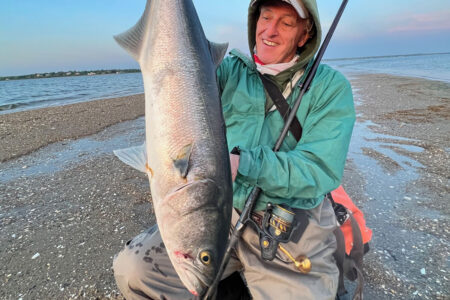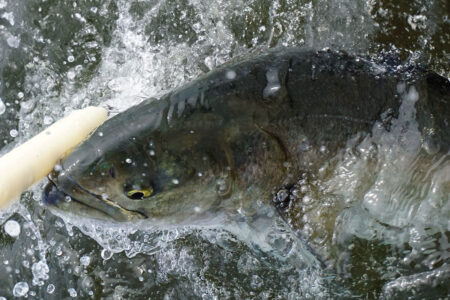
This very well could be the season of the bluefish.
Famine versus feast, that’s how I would describe the 2022 bluefish run in the Northeast compared to the run we’ve had so far this season. Talking to my Fisherman Magazine colleagues, we all agreed that, for the most part, the run of bluefish and the duration of the run was one of the best we’ve seen in years. The past few years only brought short pushes during the spring months, and as quickly as they came in, they were gone, nowhere to be found.
In 2023 it’s been a totally different game, and there have been no signs of a slowdown going into the fall. The players are all in place (bait and blues), and the weather is about to make that sudden change that will most certainly jumpstart the bite for these large blues, opening up an excellent surf fishing opportunity for those wanting to tangle with a gator.
When going after big fall blues from the surf, you have to keep in mind these are probably going to be some of the bigger ones you’ll come across all year. These fish will be fat and fierce in the cool, oxygenated water. Don’t skimp on using stout surf tackle for both the purpose of casting big plugs and turning those big bruisers around. I’ve had a few blues over 15 pounds really get the best of me on light tackle, throw some current into the mix, and it’s a recipe for an unnecessarily long fight.
Use 30-pound braid at minimum, and I’d suggest going with 40. Bluefish aren’t usually line-shy, so I have found myself using up to 80-pound monofilament to combat their sharp teeth. But still, be prepared to lose tackle, and if you see the slightest sign of a frayed leader, take the time to re-tie. Even more important might be the size of the reel you decide to use. I like to make good use of my Van Staal 250 for this type of fishing due to its cranking power. I pair this with a 10- to 11-foot, moderate action rod capable of throwing up to 5 ounces.
Think big when going after big fall bluefish. Most of the time, you can’t beat a big surface commotion when the conditions allow for it, so casting surface plugs from 7 to 10 inches like big Polaris poppers, pencil poppers, and if the fish become picky — large surface spooks. With the fall season comes fall winds, and topwater plugs will not always be the most effective. That’s when larger spoons and tins enter the game. Tins like Kastmasters, Hopkins, and Krocodile spoons work well when the fish are keyed in on wider profile baits such as peanut bunker, mullet, and squid, while the basic Ava Jig will shine when sand eels or spearing top the menu.
As a general rule of thumb, I like to focus on the outflows of bays and harbors where baitfish will eventually need to exit. I typically target the beginning of the dropping tide, but the tail end of the tide can also be productive. If sand eels happen to make a solid showing, the sand beaches are a better place to spend your time. This is when those long casts with Ava Jigs (diamond jigs) will come in handy. I haven’t heard of a spectacular sand beach bluefish run in some years now, but that could all change this year, considering the number of large bluefish sticking around throughout the region in inshore waters. Back in the heyday of these fall bluefish runs, casters would be lined up with every rod bent over on a gator bluefish during daylight hours.
Also, keep in mind that while we’re focusing on the blues here, right when the sun went down, the bluefish bite would switch over to bass in the same spots. These were simply the large and lazy stripers coming in to pick up the scraps that the blues left behind.
This very well could be the fall of the bluefish from the surf, considering what we have experienced during the spring and summer months. You better make sure you’re prepared, because they certainly will wreak havoc if they come in hot and heavy.



